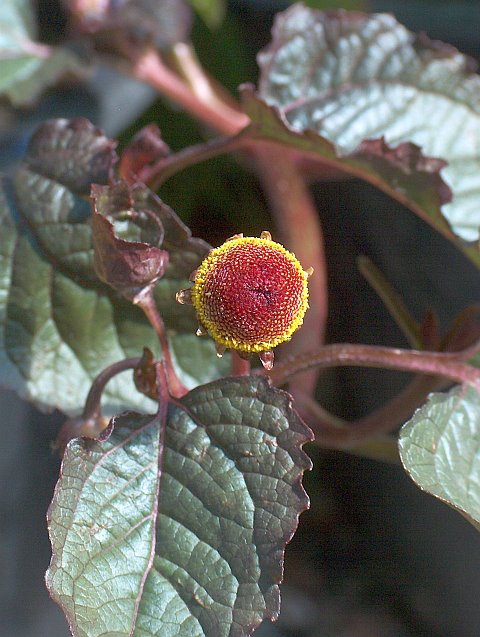Wonderful rain on the balcony (aka zone 0.5) with oca (Oxalis tuberosa), 9 varieties of lettuce (salat), tomato “42 days” , dill, coriander, toothache pant (Spilanthes), shungiku / kronkrage and lots of celery (around the corner). The large bucket in the corner contains burdock providing seed fot goldfinches (stillits) and greenfinches (grønnfink) in winter (a living bird feeder!)
Tag Archives: toothache plant
Buzz Buttons
Serving a side-salad of leaves of Acmella (Spilanthes) oleracea is guaranteed to get the juices flowing and lead to a lively discussion at dinner… Widely known as the Toothache plant as chewing the leaves/flowers has an analgesic (numbing) effect: “Eating a whole flower bud results in a grassy taste, followed by an extremely strong tingling or numbing sensation and often excessive saliva production and a cooling sensation in the throat”. Hence also the alternative name Buzz Balls (the flower buds). I would describe the initial taste explosion as citrousy. It’s not true that you start frothing excessively from the mouth on chewing some leaves. :) The effect is due to the presence of spilanthol… I usually have a pot or two of this plant in my garden to give a bit of excitement to unsuspecting guests – they usually think I’ve poisoned them…. This is also a prime annual edimental as you can see in the picture from the Lund Botanical Garden in Sweden. However, it is unfortunate that slugs are mad on this plant and will quickly defoliate your plants if you turn your back! I therefore grow mine in pots so that I can keep them out of the reach of the slugs… This is a native of Brazil where it is commonly used in salads and it is also used as a green vegetable (cooking destroys the toothache effect). This album was stimulated by a post by Stine Syvertsen on the Planteklubben group when I first posted it on FB back in 2012. Stine wrote about this herb also being used in Madagascar where it is known as Anamalao. It grows well and sets seed most years with me…It is also used medicinally and is for example a traditional remedy to stammering! – it certainly stimulates the vocal chords is my experience! Another interesting use is that if you have a guest for dinner who doesn’t like chili, you don’t need to make a separate chili-free version of whatever you’re cooking, just give your guest a few Acmella leaves to chew first!





